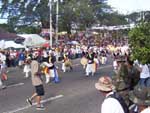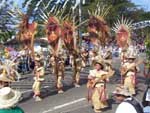Cebu's
"Sinulog" is a cornucopia of movement, sound, color, and
pageantry. This festival traces its roots to a fervent attachment to the
image by many of Cebu's inhabitants; the ritual dance evolved from the
elders' rhytmic movements while praying at the image's sanctuary, a
beautiful church edifice near Cebu's waterfront. The merrymaking draws
believers and unbelievers alike. Thus, there is something for everyone:
a pilgrimmage that is joined by thousands of faithful.
Before
1980, Sinulog was just a religious ritual. It was performed inside the
San Agustin Church (since renamed Basilica Minore del Santo Niño) -
mostly by old women who held one candle in each hand as they did the
patterned forward-backward dance of the Sinulog. A small drum sounded
out a beat nearby. The dance, in its pagan origins, was designed to
mimic the flow of the current of Cebu’s Pahina River. And the Cebuano
word of "current" is used to form the festival's name.
In
1980, with the example of the successful festivals in neighboring Panay,
city leaders organized the first ever Sinulog parade. In 1981, it became
a full festival. The festival's parade is usually a history presentation
which shows the links between the island's pagan past and its Christian
present. Seven floats were created to depict seven different periods of
history. Dancers wear costumes depicting the periods. The Sinulog has
become one of the country's biggest spectacle -- less rowdy, perhaps,
than the festivals of nearby Panay, but with better facilities and
accommodations for foreign guests. |

 Sinulog
Sinulog 





























